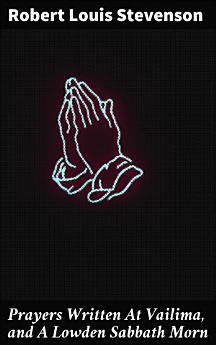Prayers Written At Vailima, and A Lowden Sabbath Morn: Meditative Prayers and Spiritual Reflections in Nature
Nov 2019 · Good Press
Ebook
136
Pages
family_home
Eligible
info
reportRatings and reviews aren’t verified Learn More
About this ebook
In "Prayers Written At Vailima, and A Lowden Sabbath Morn," Robert Louis Stevenson combines profound spirituality with lyrical prose, capturing the essence of his contemplations at Vailima, Samoa. The text serves as a reflection of Stevenson's exploration of faith, doubt, and the search for an inner moral compass amidst the beauty of the South Pacific landscape. The literary style, infused with a poetic cadence, invites readers to engage with profound theological themes while also contextualizing Stevenson's personal journey, effectively merging his narrative flair with contemplative devotion. The collection poignantly juxtaposes personal prayer against the backdrop of colonialism and cultural upheaval, offering a unique dialogue between the sacred and the mundane. Stevenson, known primarily for his novelistic prowess in works like "Treasure Island," often grappled with his own spiritual beliefs, which were influenced by his tumultuous health and a yearning for solace in nature. His relocation to Samoa and subsequent engagement with local culture profoundly shaped his worldview, culminating in these reflective prayers that articulate a quest for peace and understanding in an often chaotic life. This book is highly recommended for those seeking a deeper understanding of spirituality through the lens of a master storyteller. Stevenson's delicate balance of poetic beauty and earnest reflection invites readers from all backgrounds to ponder life's deeper questions, making it a timeless addition to both literary and spiritual discourse.
About the author
Novelist, poet, and essayist Robert Louis Stevenson was born in Edinburgh, Scotland. A sickly child, Stevenson was an invalid for part of his childhood and remained in ill health throughout his life. He began studying engineering at Edinburgh University but soon switched to law. His true inclination, however, was for writing. For several years after completing his studies, Stevenson traveled on the Continent, gathering ideas for his writing. His Inland Voyage (1878) and Travels with a Donkey (1878) describe some of his experiences there. A variety of essays and short stories followed, most of which were published in magazines. It was with the publication of Treasure Island in 1883, however, that Stevenson achieved wide recognition and fame. This was followed by his most successful adventure story, Kidnapped, which appeared in 1886. With stories such as Treasure Island and Kidnapped, Stevenson revived Daniel Defoe's novel of romantic adventure, adding to it psychological analysis. While these stories and others, such as David Balfour and The Master of Ballantrae (1889), are stories of adventure, they are at the same time fine studies of character. The Master of Ballantrae, in particular, is a study of evil character, and this study is taken even further in The Strange Case of Dr. Jekyll and Mr. Hyde (1886). In 1887 Stevenson and his wife, Fanny, went to the United States, first to the health spas of Saranac Lake, New York, and then on to the West Coast. From there they set out for the South Seas in 1889. Except for one trip to Sidney, Australia, Stevenson spent the remainder of his life on the island of Samoa with his devoted wife and stepson. While there he wrote The Wrecker (1892), Island Nights Entertainments (1893), and Catriona (1893), a sequel to Kidnapped. He also worked on St. Ives and The Weir of Hermiston, which many consider to be his masterpiece. He died suddenly of apoplexy, leaving both of these works unfinished. Both were published posthumously; St. Ives was completed by Sir Arthur Quiller-Couch, and The Weir of Hermiston was published unfinished. Stevenson was buried on Samoa, an island he had come to love very much. Although Stevenson's novels are perhaps more accomplished, his short stories are also vivid and memorable. All show his power of invention, his command of the macabre and the eerie, and the psychological depth of his characterization.
Rate this ebook
Tell us what you think.
Reading information
Smartphones and tablets
Install the Google Play Books app for Android and iPad/iPhone. It syncs automatically with your account and allows you to read online or offline wherever you are.
Laptops and computers
You can listen to audiobooks purchased on Google Play using your computer's web browser.
eReaders and other devices
To read on e-ink devices like Kobo eReaders, you'll need to download a file and transfer it to your device. Follow the detailed Help Center instructions to transfer the files to supported eReaders.







